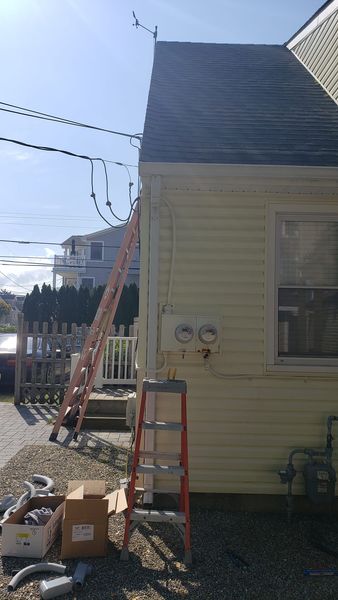Have you ever required a 4 copper jumper to bond the neutral to the electrode ground, or do you typically bond it to the can or use a separate ground bar in the panel?
9 months ago
Last Updated: September 10, 2024




Which code cycle are you following in your area?
2020. I have always opted to use the meter can with a ground lug mounted for my EC, which is then bonded to the neutral.
#6 is the largest size required for a ground rod.
I’m not entirely sure what you’re getting at here. The rounding Electrode Conductor size is determined from table 250.66 based on the service conductor size. For a 200A service using 4/0 aluminum conductors, yes, a 4 AW copper EC is necessary. And the EC SHOULD be connected to the grounded (neutral) conductor. The EC MAY be connected to the equipment grounding conductor terminal if a wire type main bonding jumper sized according to table 250.102(C)(1) is installed between the EC terminals and the grounded conductor terminals. For the same 200A service with 4/0 aluminum conductors, yes, a 4 AW copper MBJ is needed for this.
And for EC to ground rods only, 6 is the largest required.
That’s accurate.
Only if the EC connects solely to rod, pipe, or plate electrodes or any combination of those. If the EC also connects to any other type of electrode that requires a larger conductor, 6 AW is not the largest required.
Additional grounding electrode conductor is a number six, which is the largest for the ground rods only. It doesn’t matter what size service it is. Now, the grounding electrode conductor that will, let’s say, connect to the copper water main is based on the size of the service entrance conductors. As mentioned earlier, if it’s a 200 amp service with 4/0 service entrance conductors, the grounding electrode conductor would be #4 THHN or bare
I haven’t run to rods and then on to more. Always a separate run
Inspector came by. I had the 2 meter pans and usually I’ll put a lug in the meter and run my EC to that. He mentioned I need to have a jumper from the neutral to the EC sized #4. I haven’t had to do that before. He said the meter can’t be the bond to the neutral for the EC…. I fixed it by looping the neutral in the splice trough through a double lug then down to one meter
Connecting hot to ground in the panel, or EC to electrodes based on table …
6 is the biggest size needed for ground rods
I will need to check the size for the main bonding jumper
Mentioned that he preferred bonding the neutral to the EC with a #4 instead of the usual method of bringing the EC to a lug bolted to the meter can. He explained that using the meter can as the ground bond for the neutral is not recommended, even if the neutral is directly mounted to the meter can.
200 Amp
2/0 copper, yes. But I’ve never had to use an actual jumper. It wasn’t about the size of the jumper. The meter can always served as the bond.
I’ve never installed the meter can. I either use a meter main outside or run the ground inside
I didn’t realize it could be a problem. It’s just the ground, it doesn’t carry current
When a fault occurs…
But issues arise quickly. The neutral is already connected to the meter can. I managed to resolve it. I simply passed the neutral through a double lug secured in the splice box and connected the EC
Can carry the ground. Not neutral bond
No content
The attachment point in the picture definitely doesn’t seem to be 12 feet away.
Also the weather head should be above the POA, there are exceptions but they don’t apply here
It just needs to be 10′
It’s supposed to be 10′ by code and the original point was at 9′ but that one is right at 12′
Yep I tried to make them stay close to even
I might get in trouble for that. Didn’t realize it looked so much higher from the ground
No worries at all. You probably won’t! I often see small issues like that, but overall, it looks pretty good. I typically use SE cable as it blends in better than pipe. Some services may require pipe, but personally, I would have chosen SE for this job.
Unfortunately, the location being near the ocean means that the SE cable deteriorates quickly. In my area, I prefer using pipe and copper. I believe it’s close enough that the inspector won’t have any issues.
You can actually see the previous one down to the right by about 3 feet at the corner.
I get what you’re saying. When I look at those images, the existing SE cable doesn’t appear to be in bad shape. It’s likely over 30 years old at this point, but with the conduit, it should last much longer.
Trading cryptocurrency successfully in the current bear market requires both experience and a solid strategy. That’s why I rely on the trusted and profitable signals provided by Mrs. Laura Andreas. Since joining her platform, I have made significant profits using her easy-to-implement trading strategy. For more information, feel free to contact her at 📥📥📥◀️ Laura Andreas
According to Code Number 6, two grounding rods are required for earthing, with a continuous wire.
Yes number 4 on a 2-meter service. Those are both 100 amp sockets, (200 amp. Capacity) and the AHJ will not accept bonds as continuity.
Direct connection in this situation.
I have always done it the opposite way for years. I wonder if this is a recent requirement or just a rule that was never strictly enforced?
Hey Rob, I have been following this practice on my projects for 40 years.